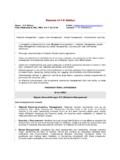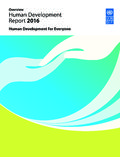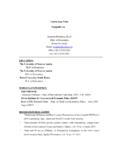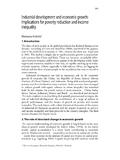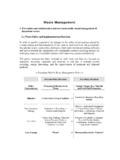Transcription of The PISA Results and the Education System in Korea
1 1 Mee-Kyeong LeeResearch FellowKorea institute of Curriculum & Evaluation (KICE)The PISA Results and the Education System in Korea2 Outline Introduction to KoreaThe PISA Results for KoreaThe CBAS Results for KoreaThe Korean Education System Current reform initiatives3 Introduction to KoreaTotal land area: 222,154 square kilometers Divided by a 241 kilometers demilitarized zoneSouth Korea : 99,313 square kilometers Population: 49 million people (2008)4 Economic DevelopmentGDP (Unit: US$ billion)28642645129701960197019801990200 02007 GNI per Capita (Unit: US$)762541645614710841200451960197019801 99020002007 Source: The bank of Korea5 The PISA Results for Korea6 Trends in Student Achievement in Korea500510520530540550560 ReadingMathScienceMeanPISA 2000 PISA 2003 PISA 20067 Trends in ReadingPISA 2000 PISA 2003 PISA 2006 CountryMeansCountryMeansCountryMeansFinl andCanadaNew in Reading 350400450500550600 Argentina ---Romania ---Spain ---Bulgaria ---Japan ---Iceland ---Russian Federation ---Norway ---Italy ---France --Australia --Greece -Thailand --Israel oMexico -Ireland oSweden oCzech Republic oNew Zealand oCanada oBelgium oBrazil oDenmark oAustria oFinland oPortugal oHungary oSwitzerland oHong Kong-China +Germany oLatvia +++Indonesia ++Liechtenstein +++Poland +++ Korea +++Chile +++ScoreReading score in PISA 2006 Reading score in PISA 2000 Source.
2 OECD(2006) PISA 2006 volume 1 Figure in MathematicsPISA 2000 PISA 2003 PISA 2006 CountryMeansCountryMeansCountryMeansJapa nKoreaNew TaipeiFinlandHong ---Japan --Liechtenstein -Iceland ---Belgium --United States -Netherlands -Sweden -Czech Republic oSlovak Republic oCanada -Norway oSpain oAustralia oItaly oLuxembourg oHong Kong-China oMacao-China oNew Zealand oIreland oDenmark oAustria oThailand oPortugal oTurkey oGermany oHungary oLatvia oSwitzerland oFinland oUruguay oPoland oKorea oTunisia oRussian Federation oBrazil ++Greece +++Mexico +++Indonesia +++ScoreMath scores in PISA 2006 Math scores in PISA 2003 Trends in MathematicsSource: OECD(2006) PISA 2006 volume 1 Figure in SciencePISA 2000 PISA 2003 PISA Kong-ChinaCanadaChinese TaipeiEstoniaJapanNew between PISA 2006 and PISA 2003 science scores based on link items.
3 (not statistically significant)12 Percentages of Students at the Top Proficiency Level0510152025 ReadingMathScience%PISA 2000 PISA 2003 PISA 200613% of Students at Each Proficiency Level on the Reading Scale (PISA 2006)10080604020020406080100 KoreaFinlandHong Kong-ChinaCanadaIrelandNew ZealandLiechtensteinAustraliaNetherlands SwedenPolandEstoniaBelgiumSwitzerlandChi nese TaipeiGermanyJapanSloveniaDenmarkUnited KingdomMacao-ChinaFranceAustriaIcelandNo rwayHungaryCzech RepublicLuxembourgLatviaCroatiaPortugalI talyLithuaniaSlovak RepublicGreeceSpainIsraelTurkeyChileRuss ian FederationUruguayBulgariaMexicoThailandA rgentinaSerbiaJordanBrazilColombiaRomani aMontenegroTunisiaIndonesiaQatarAzerbaij anKyrgyzstanLevel 2 Level 1 Below Level 1 Level 3 Level 4 Level 5 Level 5: 4: 3: 2: 1: Level 1: : OECD(2006) PISA 2006 volume 1 Figure of Students at Each Proficiency Level on the Mathematics Scale (PISA 2006)10080604020020406080100 FinlandKoreaHong Kong-ChinaAzerbaijanCanadaMacao-ChinaNet herlandsChinese TaipeiEstoniaAustraliaJapanLiechtenstein SwitzerlandDenmarkNew ZealandIrelandIcelandBelgiumSloveniaSwed enCzech RepublicUnited KingdomPolandGermanyAustriaLatviaSlovak RepublicHungaryNorwayFranceLuxembourgLit huaniaSpainRussian FederationUnited StatesCroatiaPortugalGreeceItalyIsraelSe rbiaUruguayTurkeyRomaniaThailandBulgaria ChileMexicoMontenegroArgentinaIndonesiaJ ordanColombiaTunisiaBrazilQatarKyrgyzsta nLevel 1 Below Level 1 Level 2 Level 3 Level 4 Level 5 Level 6%Level 6: 5: 4: 3: 2: 1: Level 1.
4 OECD(2006) PISA 2006 volume 1 Figure of Students at Each Proficiency Level on the Science Scale (PISA 2006)10080604020020406080100 FinlandEstoniaHong Kong-ChinaCanadaMacao-ChinaKoreaChinese TaipeiJapanAustraliaLiechtensteinNetherl andsNew ZealandSloveniaHungaryGermanyIrelandCzec h RepublicSwitzerlandAustriaSwedenUnited KingdomCroatiaPolandBelgiumLatviaDenmark SpainSlovak RepublicLithuaniaIcelandNorwayFranceLuxe mbourgRussian FederationGreeceUnited StatesPortugalItalyIsraelSerbiaChileUrug uayBulgariaJordanThailandTurkeyRomaniaMo ntenegroMexicoArgentinaColombiaBrazilInd onesiaTunisiaAzerbaijanQatarKyrgyzstanLe vel 1 Below Level 1 Level 2 Level 3 Level 4 Level 5 Level 6 Level 6: 5: 4: 3: 2: 1: : OECD(2006) PISA 2006 volume 1 Figure Reasons Behind Different Achievement Levels Across the Three Domains17 Why is Achievement in Science Declining?
5 The instructional time in science was reduced an average of 45 minutes a week for grade 4, 5, 6, 7, subjects became optional, not core for grade 11 and 12 and Technology professions have become less attractive to Korean students. The university entrance System changed. Students don t need to take exams on science although they will continue their studies in areas related to science in Perceptions of the Importance of Doing Well in Science, Reading and Mathematics5060708090100 ThailandJordanColombiaKyrgyzstanTunisiaI ndonesiaChileMexicoBrazilAzerbaijanArgen tinaLithuaniaUnited KingdomCanadaUruguayPortugalQatarBulgari aUnited StatesEstoniaItalyTurkeyMacao-ChinaRoman iaChinese TaipeiNorwayPolandMontenegroGermanyNew ZealandRussian FederationKoreaIrelandGreeceSpainSwedenN etherlandsAustraliaSloveniaHong Kong-ChinaLatviaDenmarkIsraelIcelandJapa nLuxembourgHungaryAustriaSerbiaLiechtens teinBelgiumFranceCroatiaSwitzerlandFinla ndSlovak RepublicCzech RepublicSci enceReadi ngMathemati csSource.
6 OECD(2006) PISA 2006 volume 1 Figure is Achievement in Reading Improving?The new national curriculum put more emphasis on critical and creative thinking skills through reading and assessment more focused on thinking university entrance System changed. Essay test that assesses both writing skills and logical thinking abilities introduced. 20 Attitudes Toward Each DomainAttitudes toward each domain are relatively low. 21 General Interest in Science020406080 What is required for scientificexplanationsTopics in geologyWays scientists design experimentsThe biology of plantsTopics in physicsTopics in chemistryTopics in astronomyHuman biologyOECD averageKoreaSpainSource: OECD(2006) PISA 2006 volume 1 Figure of Science01020304050607080I am happy doing scienceproblems. I like reading about am interested in learning aboutscience.
7 I generally have fun when I amlearning science topics. I enjoy acquiring new knowledgein averageKoreaSpainSource: OECD(2006) PISA 2006 volume 1 Figure in Science010203040506070 School science topics are easy for me. Learning advanced school sciencetopics would be easy for me. I can easily understand new ideas inschool science. I learn school science topics I am being taught school science,I can understand the concepts very well. I can usually give good answers to testquestions on school science topics. OECD averageSpainKoreaSource: OECD(2006) PISA 2006 volume 1 Figure RepublicSwitzerlandLuxembourgDenmarkPort ugalGreecePolandMexicoItalyUnited KingdomBelgiumUnited StatesFranceAustraliaNew ZealandAustriaNorwayIrelandCanadaSwedenF inlandIcelandKoreaJapanSpain420440460480 500520540560-20-15-10-50510152025 Equity in Reading Literacy (PISA 2000)Social equityReadingliteracyHigh qualityLow equityHigh qualityHigh equityLow qualityLow equityLow qualityHigh equitySource.
8 OECD(2001) Knowledge and skills for life, Table StatesTurkeySwitzerlandSwedenSpainSlovak RepublicPortugalPolandNorwayNew ZealandNetherlandsMexicoLuxembourgKoreaJ apanItalyIrelandIcelandHungaryGreeceGerm anyFranceFinlandDenmarkCzech RepublicCanadaBelgiumAustriaAustralia375 400425450475500525550-15-10-5051015 Equity in Mathematics Literacy (PISA 2003)Social equityMathematics literacyHigh qualityLow equityHigh qualityHigh equityLow qualityLow equityLow qualityHigh equitySource: OECD(2004) Learning for tomorrow s world, Table in ScienceLiteracy (PISA 2006)SwedenPortugalBulgariaCzech RepublicJapanHong Kong-ChinaMontenegroGreeceChinese TaipeiThailandAzerbaijanEstoniaUruguayCh ileIndonesiaSpainBrazilRomaniaArgentinaR ussian FederationLiechtensteinBelgiumLithuaniaA ustriaCanadaLatv iaNew ZealandMexicoJordanCroatiaIrelandColombi aUnited KingdomAustraliaUnited StatesFinlandIcelandTunisiaIsraelKy rgy zstanNorwaySlov eniaHungaryMacao-ChinaPolandTurkeyNether landsSerbiaItalyLuxembourgDenmarkSlov ak RepublicKoreaFranceSwitzerlandGermany300 3504004505005506000102030 OECD meanSource.
9 OECD(2006) PISA 2006 Volume 1, figure qualityLow equityHigh qualityHigh equityLow qualityLow equityLow qualityHigh equitySocial equity27 The CBAS Results for Korea28 Implementation of CBASAims: to add value to science assessment and to implement computer-based assessment in an international setting. Participating countries: Korea , Denmark, Iceland When : June 2006 The number of Korean schools participated: 79 The number of Korean students participated: About 1500 (20 students per school)Testing Period: 1-hour29 Characteristics of CBAS ItemsAdding value to science assessmentallowing assessment of aspects of science not available in paper and pencil testproviding real life contexts by using simulations and videosProduction of items consistent with the conceptual framework for PISA 2006 Reducing reading load in order to reduce influence of reading abilityMinimising ICT skills requirement in CBAS30 Gender Differences by RegionCBAS Means by Gender4864924884895095384825154504604704 80490500510520530540550 MetropolitanUrbanRuralTotalRegionMean scoreFemaleMalePaper and Pencil Tes t Means by Gender5035064905004975204664944304404504 60470480490500510520530 M etropolitanUrbanRuralTotalRegionMean scoreFemaleM ale31 Enjoyment of CBAS & Test1,36,631,016,744,43,35,726,518,845.
10 701020304050 Strongly DisagreeDisagreeAgreeStrongly agreeNo response(%)Enjoyment of Computer Based Assessmentgirlboy7,527,916,63,644,411,12 4,014,94,345,70 10 20 30 40 50 Strongly DisagreeDisagreeAgreeStrongly agreeNo response(%)Enjoyment of Paper and Pencil Testgirlboy32 What do the PISA Results Mean for the Korean Education ?The PISA Results provided an opportunity: To restore public trust in public educationto identify the strengths and weakness of the Korean educational systemto re-confirm the necessity of efforts to maintain and develop students high achievement during their university studies and into their adulthood33 The Korean Education System34 Population that Has Attained at Least Tertiary Education (2006)0102030405060708090100 Russian Federation 1 Canada Japan Korea Israel New Zealand Ireland Belgium Norway France Denmark United States Spain Sweden Australia Finland United Kingdom Netherlands Luxembourg Estonia Switzerland Iceland Poland Greece Slovenia Germany Hungary Portugal Austria Mexico Chile 2 Italy Slovak Republic Czech Republic Turkey Brazil 225-to-34-year-olds 55-to-64-year-olds 1.





